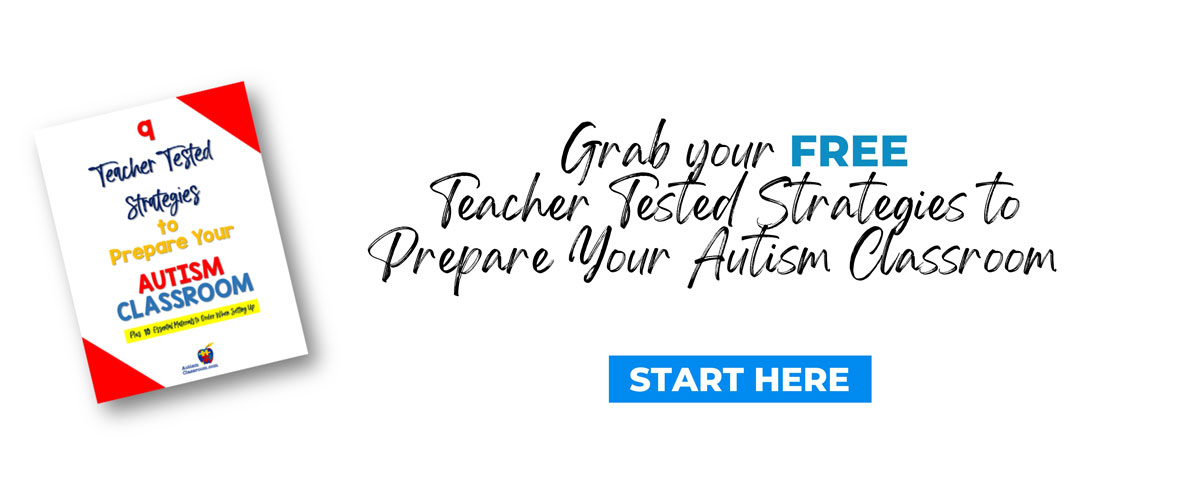
Inside: teaching children with autism to read, autism and reading strategies, and phonics instruction for students with autism
Teaching phonics to students with limited verbal ability or who are non-speaking can feel challenging, but with the right strategies they can begin to develop reading skills. Teaching children with autism to read involves a variety of reading techniques. Because many phonics activities rely on oral repetition, it's important to provide alternative ways for students to engage with letter sounds, blending, and decoding. Providing minimally verbal and nonverbal autistic students with a multi-sensory, interactive approach allows them to show what they know in ways that work for them.
1. Make it Multi-Sensory
Instead of focusing on speaking, let students interact with phonics through:
- Tactile learning. Use magnetic letters, letter tiles, or letter flashcards to physically manipulate letter sounds. The Phonics Reading Skills for Students with Autism – CVC Words includes some cut-and-paste activities that encourage hands-on learning.

- Visual supports. Elkonin boxes can be used for students to move objects to represent phonemes. Or, try our Phonemic Awareness Phonics Reading Skills Printables for Students with Autism — designed for students with autism to build strong phonemic awareness with interactive worksheets.

- Finger tracing. Have students trace letters while hearing their sounds.
2. Use Augmentative and Alternative Communication (AAC) Devices
AAC tools help students engage with phonics by selecting sounds and letters on their device or communication board. You can:
- Program letter sounds into an AAC device so students can repeat the sound even if they are not yet using words.
- Offer choices from various word cards or letter cards instead of expecting a vocal response when teaching children with autism to read.
- Encourage students to build words using AAC tools or letter-based apps.
3. Incorporate Phonics Apps & Technology
Technology is a great way to reinforce phonics to minimally verbal and nonverbal autistic students without requiring speech. Some tools you could try are:
- Interactive phonics apps with sound feedback.
- Digital flashcards that pair sounds with letters and images.
- Interactive Display Boards where students can answer using the board.
- Speech-to-text programs for students who can type but not speak.

4. Teach Phonemic Awareness with Alternative Response Methods
Some students may struggle to verbalize sounds, but they can still demonstrate phonics knowledge in other ways. They might gesture or point to the correct letter or word, sort and match images with corresponding sounds, or move objects to represent phonemes instead of saying them.
A great tool for this is our phonics task cards, which provide structured yet flexible ways for teaching students with autism to read and to help students to show what they know.

Task cards can allow students to match words to pictures, identify the correct word from a set of options, or decode simple words independently. These can be laminated for durability, used with dry-erase markers, or used with clothespins, making them a versatile and hands-on option. Other things to try are:
- Gesture or point to the correct letter or word.
- Sort and match images with corresponding sounds or words. See our Phonics Reading Skills for Students with Autism – CVC Words page that practices this skill.

5. Engage with Hands-On Literacy Activities
Students learn best when they're actively involved, so it’s helpful to incorporate hands-on activities. Try using cut-and-paste activities to match letters with words, engaging students with phonics games like letter puzzles or scavenger hunts, or reinforcing word recognition through picture-word matching. Some games you can try with your students minimally verbal and nonverbal students with autism include:
- Cut-and-paste activities from the Phonics Reading Skills for Students with Autism – CVC Words. This allows students to match letters with words.

- Phonics games like letter puzzles or scavenger hunts. These types of games help to reinforce skills in an engaging way when teaching children with autism to read.
- Picture-word matching or word to word matching activities from our Phonics CVC Word resource support word recognition.

6. How to Assess Phonics Knowledge in Non-Speakers (Autism and Reading Assessment Ideas)
Assessment doesn’t have to mean verbal responses. Instead, try:
- Matching Activities: Have students match sight words to pictures like we do in our resource here.
- Pointing or Selecting Responses: Offer multiple choices and have students choose the correct one using an AAC device or pointer.
- Building Words: Give students letter tiles or a magnetic board to form CVC words. If they move objects, make the letter cards on an index card and laminate it.
- Sorting Tasks: Ask students to sort words by beginning or ending sounds.

- Observational Notes: Track how students engage with phonics activities during independent work or structured lessons.
- Digital Assessments: Apps that track progress in students with autism and reading skills like recognizing sounds and letter patterns can be a great low-pressure way to assess skills.
Need a Ready-Made Phonics Resource?
If you’re looking for phonics materials specifically designed for non-speakers or students with limited verbal ability, we’ve got you covered with the Phonics Reading Skills for Students with Autism – CVC Words and Phonics Reading Skills Printables for Students with Autism - Phonemic Awareness. They are resources made with non-verbal learners in mind, using hands-on activities like matching, sorting, and cutting-and-pasting exercises, as well as word-to-picture activities.
Get your markers, find your scissors, and take this gift of time that you won’t be using making worksheets to build your skills of teaching children with autism to read. These can be an easy way to introduce and reinforce CVC words without relying on spoken responses. You can find them here.
Teaching phonics to non-speaking or minimally verbal students takes creativity, but it’s absolutely possible. By focusing on alternative response methods, hands-on activities, and multi-sensory instruction, you can make phonics instruction work for your students.

